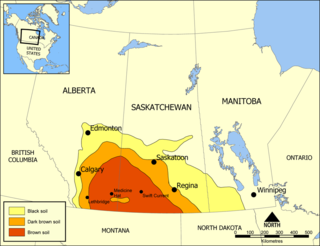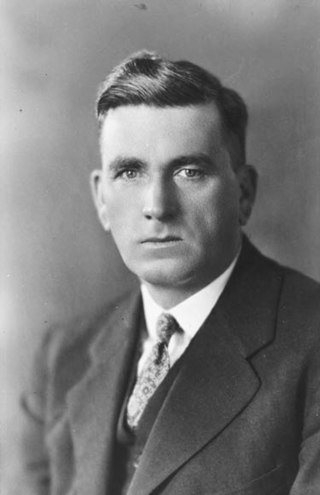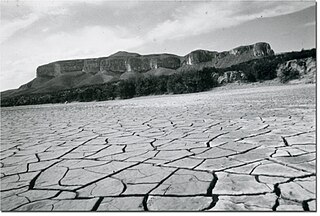Related Research Articles

The Agricultural Marketing Act of 1929, under the administration of Herbert Hoover, established the Federal Farm Board from the Federal Farm Loan Board established by the Federal Farm Loan Act of 1916 with a revolving fund of half a billion dollars. The original act was sponsored by Hoover in an attempt to stop the downward spiral of crop prices by seeking to buy, sell and store agricultural surpluses or by generously lending money to farm organizations. Money was lent out to the farmers in order to buy seed and food for the livestock, which was especially important since there had previously been a drought in the Democratic South. However, Hoover refused to lend to the farmers themselves, as he thought that it would be unconstitutional to do so and if they were lent money, they would become dependent on government money.

The Agricultural Adjustment Act (AAA) was a United States federal law of the New Deal era designed to boost agricultural prices by reducing surpluses. The government bought livestock for slaughter and paid farmers subsidies not to plant on part of their land. The money for these subsidies was generated through an exclusive tax on companies which processed farm products. The Act created a new agency, the Agricultural Adjustment Administration, also called "AAA" (1933-1942), an agency of the U.S. Department of Agriculture, to oversee the distribution of the subsidies. The Agriculture Marketing Act, which established the Federal Farm Board in 1929, was seen as an important precursor to this act. The AAA, along with other New Deal programs, represented the federal government's first substantial effort to address economic welfare in the United States.

The Dust Bowl was the result of a period of severe dust storms that greatly damaged the ecology and agriculture of the American and Canadian prairies during the 1930s. The phenomenon was caused by a combination of natural factors and human-made factors: a failure to apply dryland farming methods to prevent wind erosion, most notably the destruction of the natural topsoil by settlers in the region. The drought came in three waves: 1934, 1936, and 1939–1940, but some regions of the High Plains experienced drought conditions for as long as eight years.

Palliser's Triangle, or the Palliser Triangle, is a semi-arid steppe occupying a substantial portion of the Western Canadian Canadian Prairies, Saskatchewan, Alberta and Manitoba, within the Great Plains region. While initially determined to be unsuitable for crops outside of the fertile belt due to arid conditions and dry climate, expansionists questioned this assessment, leading to homesteading in the Triangle. Agriculture in the region has since suffered from frequent droughts and other such hindrances.
DRS may refer to:

Throughout Russian history famines, droughts and crop failures occurred on the territory of Russia, the Russian Empire and the USSR on more or less regular basis. From the beginning of the 11th to the end of the 16th century, on the territory of Russia for every century there were 8 crop failures, which were repeated every 13 years, sometimes causing prolonged famine in a significant territory. The causes of the famine were different, from natural and economic and political crises; for example, the Great Famine of 1931–1933, colloquially called the Holodomor, the cause of which was the collectivization policy in the USSR, which affected the territory of the Volga region in Russia, Ukraine and Kazakhstan.
The Exchange Stabilization Fund (ESF) is an emergency reserve fund of the United States Treasury Department, normally used for foreign exchange intervention. This arrangement allows the US government to influence currency exchange rates without directly affecting domestic money supply.
In 2006, an acute shortage of food affected the countries in the Horn of Africa, as well as northeastern Kenya. The United Nations's Food and Agriculture Organization (FAO) estimated on January 6, 2006, that more than 11 million people in these countries may be affected by an impending widespread famine, largely attributed to a severe drought, and exacerbated by military conflicts in the region.

Robert Weir, was a Canadian politician.

The Federal Surplus Commodities Corporation was one of the so-called alphabet agencies set up in the United States during the 1930s as part of President Franklin D. Roosevelt's New Deal. Created in 1933 as the Federal Surplus Relief Corporation, its name was changed by charter amendment on November 18, 1935. In 1937 its administration was placed within the United States Department of Agriculture. In 1940 it was combined with other USDA initiatives to form the Surplus Marketing Administration. It was abolished February 23, 1942, with the creation of the Agricultural Marketing Administration.

The Navajo Livestock Reduction was imposed by the United States government upon the Navajo Nation in the 1930s, during the Great Depression. The reduction of herds was justified by the government by stating that grazing areas were becoming eroded and had deteriorated due to too many animals.
The agricultural policy of the United States is composed primarily of the periodically renewed federal U.S. farm bills. The Farm Bills have a rich history which initially sought to provide income and price support to US farmers and prevent them from adverse global as well as local supply and demand shocks. This implied an elaborate subsidy program which supports domestic production by either direct payments or through price support measures. The former incentivizes farmers to grow certain crops which are eligible for such payments through environmentally conscientious practices of farming. The latter protects farmers from vagaries of price fluctuations by ensuring a minimum price and fulfilling their shortfalls in revenue upon a fall in price. Lately, there are other measures through which the government encourages crop insurance and pays part of the premium for such insurance against various unanticipated outcomes in agriculture.

The United States' contiguous western and especially southwestern region has experienced widespread drought since about year 2000. Below normal precipitation leads to drought, and is caused by an above average persistence of high pressure over the affected area. Changes in the track of extratropical cyclones, which can occur during climate cycles such as the El Niño-Southern Oscillation, or ENSO, as well as the North Atlantic Oscillation, Pacific Decadal Oscillation, and Atlantic multidecadal oscillation, modulate which areas are more prone to drought. Increased drought frequency and severity is also expected to be one of the effects of global warming.

The 1988–1990 North American drought ranks among the worst episodes of drought in the United States. This multi-year drought began in most areas in 1988 and continued into 1989 and 1990. The drought caused $60 billion in damage in United States dollars, adjusting for inflation. The drought occasioned some of the worst blowing-dust events since 1977 or the 1930s in many locations in the Midwestern United States, including a protracted dust storm, which closed schools in South Dakota in late February 1988. During the spring, several weather stations set records for the lowest monthly total precipitation and the longest interval between measurable precipitation, for example, 55 days in a row without precipitation in Milwaukee. During the summer, two record-setting heatwaves developed, similar to those of 1934 and 1936. The concurrent heat waves killed 4,800 to 17,000 people in the United States. During the summer of 1988, the drought led to many wildfires in forested western North America, including the Yellowstone fires of 1988.

The Great Plains Shelterbelt was a project to create windbreaks in the Great Plains states of the United States, that began in 1934. President Franklin D. Roosevelt initiated the project in response to the severe dust storms of the Dust Bowl, which resulted in significant soil erosion and drought. The United States Forest Service believed that planting trees on the perimeters of farms would reduce wind velocity and lessen evaporation of moisture from the soil. By 1942, 220 million trees had been planted, covering 18,600 square miles (48,000 km2) in a 100-mile-wide zone from Canada to the Brazos River. Even as of 2007, "the federal response to the Dust Bowl, including the Prairie States Forestry Project which planted the Great Plains Shelterbelt and creation of the Soil Erosion Service, represents the largest and most-focused effort of the [U.S.] government to address an environmental problem".

Arvin Federal Government Camp, also known as the Weedpatch Camp or Sunset Labor Camp, was built by the Farm Security Administration south of Bakersfield, California, in 1936 to house migrant workers during the Great Depression. The National Register of Historic Places placed several of its historic buildings on the registry on January 22, 1996.
The Jones–Connally Act was a New Deal Initiative passed by Congress in April 1934 as an extension to the Agricultural Adjustment Act. Largely in response to the great drought of 1933–1934, cattle ranchers acted against their former opposition to the commodification of cattle and appealed to the government for assistance in ridding of themselves of the millions of cattle they could no longer afford to feed or to keep alive without a loss on return.

The 1950s Texas drought was a period between 1949 and 1957 in which the state received 30 to 50% less rain than normal, while temperatures rose above average. During this time, Texans experienced the second-, third-, and eighth-driest single years ever in the state – 1956, 1954, and 1951, respectively. The drought was described by a state water official as "the most costly and one of the most devastating droughts in 600 years."
Triple-A Plowed Under is a Living Newspaper play produced by the Federal Theatre Project in 1936. Written by Arthur Arent from research by the editorial staff of the Federal Theatre Project and directed by Joseph Losey, it focused on the Agricultural Adjustment Act of 1933 and the plight of Dust Bowl farmers. The production premiered on Broadway at the Biltmore Theatre on March 14, 1936 and ran until May 2, 1936.

In the early months of 2017, parts of South Sudan experienced a famine following several years of instability in the country's food supply caused by war and drought. The famine, largely focused in the northern part of the country, affected an estimated five million people. In May 2017, the famine was officially declared to have weakened to a state of severe food insecurity.
References
- ↑ "American Geosciences Institute - Serving the Geosciences Since 1948" . Retrieved 2012-03-02.
- ↑ "Timeline . Surviving the Dust Bowl . American Experience . WGBH". PBS. Retrieved 2012-03-02.
- ↑ "Historical Voices". Archived from the original on 2012-02-19. Retrieved 2012-03-02.
- ↑ "Dust Bowl was deadly" . Retrieved 2012-03-02.
- ↑ "CATTLE SLAUGHTER A BLOW TO TANNERS - Price 'Catastrophe' Laid to Surplus of Hides Created in Federal Drought Program. RELIEF MEETINGS TODAY Groups in Chicago and Boston Seek to Stabilize Market as Quotations Drop Fast. CATTLE SLAUGHTER A BLOW TO TANNERS". The New York Times. Retrieved 2012-03-02.
- ↑ Monthly Catalog, United States Public Documents, By United States Superintendent of Documents, United States Government Printing Office, Published by G.P.O., 1938